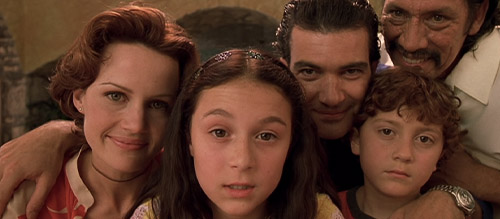‘Spy Kids’ at 20 – Review
Spy Kids (2001)
Director: Robert Rodriguez
Screenwriter: Robert Rodriguez
Starring: Alexa PenaVega, Daryl Sabara, Antonio Banderas, Carla Gugino, Danny Trejo, Alan Cumming, Tony Shalhoub, Terri Hatcher, George Clooney
As with many films from the early noughties, it will probably come as a surprise to few that Spy Kids has not aged well. Forget any memories of tight plots, astounding CGI and exemplary acting. Nostalgia is a liar.
Released in 2001, Spy Kids was written, edited, directed and produced by Robert Rodriguez, and features a strong cast in Antonio Banderas, Carla Gugino, Danny Trejo, Alan Cummings and Tony Shalhoub. George Clooney even appears at the end for what is arguably the best scene of the film. It’s a pretty harmless movie and was always intended to be a ‘smarter’ children’s film which didn’t pander to the younger audience as much. It is essentially a kid-friendly camp James Bond from the era when Bond could get into fist fights and emerge without a single scratch. Couple this with 90s gadgets, family values and Latinx heritage, and you’re good to go.
Spy Kids follows Gregorio and Ingrid Cortez (Banderas and Gugino), two former field agents for the spy organisation the OSS, who gave up missions nine years ago to focus on raising a family. Their two children, Carmen (Alexa Vega) and Juni (Daryl Sabara), have no idea about their parents’ secret lives. When their parents are captured (two minutes after leaving for a new mission – worst spies ever), Carmen and Juni are sent to a safe-house, only to have to escape and head to Floop’s (Cummings’) castle to rescue them and save the world from his robotic replica spy kids.
It is startling to see how dark the plot really is. Floop is the host of a children’s show that Juni is an avid fan of, and the characters in the show – weird looking humanoids called “Flooglies” – are actually captured OSS agents, hideously mutated and then locked up and forced to perform. This definitely isn’t expanded upon as much as it should be, and seems to be glossed over for the sake of several other arcs.
Spy Kids definitely struggles with establishing a fully formed plot, instead choosing to splice several plots together, each of which could have been full films in of themselves. Most of the movie alternates between Carmen and Juni bickering whilst travelling around to save their parents, and Gregorio and Ingrid who manage to get locked up three separate times. There are also simultaneously half-formed plot points like an insinuation that their estranged uncle (Trejo) is an arms dealer on both sides, that there’s a robot children army, that there’s something unusual about the Third Brain science experiment team, and that there may or may not be corruption inside the OSS. It’s a lot.
For a kids film, Gregorio and Ingrid are insanely horny for each other. All the time. Their chemistry is so electric that it’s almost like you’re intruding whenever they’re together. Banderas and Gugino are both excellent actors and bring the Cortez family to life with great comedic timing whilst also presenting a believable relationship dynamic. For the fact that Gregorio and Ingrid gave up field work to be OSS consultants, there is no degree of resentment to each other or to their children about their ‘safer’ lives. Even though Ingrid is desperate for an adventure, she doesn’t ever take it out on Gregorio, or the children. They have a healthy family dynamic, and it’s nice to see that Ingrid can enjoy motherhood whilst also missing active work.
Antonio Banderas and Danny Trejo are complete delights every time they are on screen, and it’s really nice to see Trejo get to have fun, especially as his character, Isador Cortez, is canonically the same Machete from the eponymous films.
Less delightful, and something which ages the film, is the constant use of green screen and CGI. Spy Kids was released during an era where CG technology was rapidly advancing and filmmakers insisted upon using it for everything, and we had to learn the hard way that less is so often more when it comes to Computer Generated Imagery. Whilst there are perhaps more famous examples of getting CG wrong, Spy Kids definitely suffers from overusing it.
In retrospect, and with many a reader’s childhood nostalgia to consider, it’s hard being critical of this film. Spy Kids was never intended to be taken seriously and it is aimed at a younger demographic. It is interesting, however, to revisit it twenty years later and discover how much of it is a hot, hot mess. There remains much to enjoy about Robert Rodriguez’s first big family hit, but Spy Kids is definitely a film that holds its shine better through the rose-tinted spectacles of childhood memories and a nostalgia for simpler times.
12/24
Recommended for you: Spy Kids Movies Ranked
You can support Darcy Rae in the following places:
Twitter – @dxrcyer
Instagram – @dxrcyer
Blog – Austen-tatious Darling


